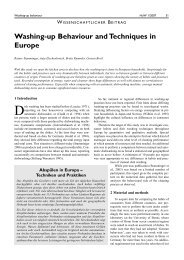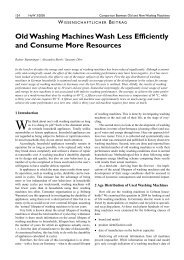Development of a novel mechatronic system for mechanical weed ...
Development of a novel mechatronic system for mechanical weed ...
Development of a novel mechatronic system for mechanical weed ...
You also want an ePaper? Increase the reach of your titles
YUMPU automatically turns print PDFs into web optimized ePapers that Google loves.
Introduction<br />
techniques. It is known that some <strong>weed</strong>s are able to grow in soil conditions<br />
suboptimal or even unfavourable <strong>for</strong> crops, so a soil testing is necessary be<strong>for</strong>e<br />
the soil nutrient or pH can be improved or the crop selected. The relationship<br />
between soil structure and <strong>weed</strong> development is similar to that <strong>of</strong> nutrients,<br />
which means indirect impact. Optimal soil structure will not help the <strong>weed</strong>ing,<br />
but pure structure, compaction and cultivation pans can lead to the spread <strong>of</strong><br />
<strong>weed</strong>s via deep underground stems or roots, or could cause the appearance <strong>of</strong><br />
waterlogged soil, preferable <strong>for</strong> some <strong>weed</strong> species.<br />
The choice <strong>of</strong> the crop should be based primarily on the soil type and climate. In<br />
cases where more options in the choice <strong>of</strong> cultivars exist, most desirable are<br />
species with rapid establishment, vigorous growth, prostrate – leafy types or<br />
long straw cereals. An increase in the sowing rate could result in an<br />
improvement <strong>of</strong> the crop’s competitiveness effect and provide compensation <strong>for</strong><br />
the losses incurred during <strong>mechanical</strong> <strong>weed</strong> control (Parish 1990).<br />
Cultivation is <strong>of</strong> great importance in <strong>weed</strong> management and it should always be<br />
properly varied depending on needs <strong>of</strong> different crop and <strong>weed</strong> populations<br />
(Mohler and Gal<strong>for</strong>d 1997). Cultivation also provides many other beneficial<br />
effects far beyond the <strong>weed</strong>s. It is important <strong>for</strong> aerating the soil, stimulating<br />
crop root growth, conserving soil moisture and providing insulation with loose,<br />
dry soil mulch. To choose an adequate cultivation mechanism <strong>for</strong> optimum<br />
<strong>weed</strong> management, it is important to know the <strong>weed</strong> history <strong>of</strong> the field and to<br />
understand their lifecycle (Buhler 1995). Different <strong>weed</strong> species require different<br />
cultivation procedures. For example one successful method against perennials<br />
is weakening <strong>of</strong> the <strong>weed</strong> plant by separation <strong>of</strong> the above – ground and<br />
underground parts, which leads to exhaustion <strong>of</strong> the food reserves in the<br />
underground part. The most significant factors <strong>of</strong> annual <strong>weed</strong>s are conditions<br />
<strong>for</strong> their germination. Germination is dependent on the correct levels and<br />
mixture <strong>of</strong> moisture, oxygen, carbon dioxide, temperature and in some <strong>weed</strong>s<br />
the presence or absence <strong>of</strong> light. Combination <strong>of</strong> these conditions <strong>of</strong>ten causes<br />
seeds to have distinct germination periods, so well timed cultivation can<br />
drastically decrease the <strong>weed</strong> population. Crop seeds are usually larger and<br />
planted deeper then most <strong>weed</strong> seeds, which provides a possibility to calculate<br />
the cultivation depth, damaging just <strong>weed</strong> plants. A seedling is most vulnerable<br />
12





